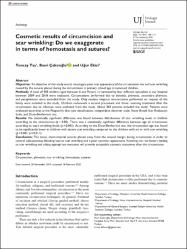Cosmetic results of circumcision and scar wrinkling: Do we exaggerate in terms of hemostasis and sutures?
Özet
Objective: To objective of this study was to investigate poor scar appearance of the circumcision line and scar wrinkling
caused by the sutures placed during the circumcision in primary school age circumcised children.
Methods: A total of 455 children aged between 6 and 9years, circumcised by four different specialists in our hospital
between 2009 and 2018 were evaluated. Circumcisions performed due to balanitis, phimosis, secondary phimosis,
and paraphimosis were excluded from the study. Only routine religious circumcisions performed on request of the
family were included in the study. Children underwent a second procedure and those receiving treatment after the
circumcision due to infection were excluded from the study. About 363 patients included the study. Patients were
evaluated according to the Fitzpatrick skin type classification, independent observer scale, Stony Brook Scar Evaluation
Scale, and Dunn-Bonferroni test.
Results: No statistically significant difference was found between distributions of scar wrinkling levels in children
according to the circumcision (p>0.05). There was a statistically significant difference between age of circumcision
according to scare wrinkling levels (p=0.001). According to the Dunn-Bonferroni test; the circumcision age was found
to be significantly lower in children with severe scar wrinkling compared to the children with no or mild scar wrinkling
(p=0.001; p=0.011).
Conclusion: The tense, short-interval sutures placed away from the wound margin during circumcision in order to
control subcutaneous bleeding lead to scar wrinkling and a poor cosmetic appearance. Knowing the risk factors leading
to scar wrinkling and taking appropriate measures will provide acceptable cosmetic outcomes after the circumcision.
Cilt
89Sayı
1Bağlantı
https://hdl.handle.net/11363/4988Koleksiyonlar
Aşağıdaki lisans dosyası bu öğe ile ilişkilidir:


















